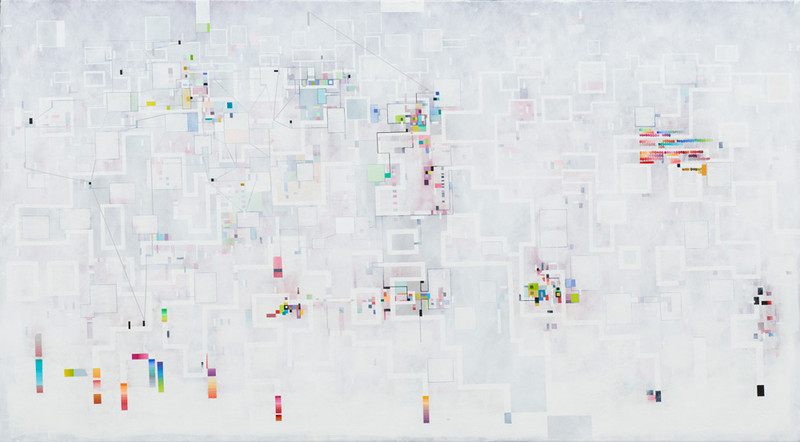Bart Stolle
16 Mar - 28 Apr 2012
BART STOLLE
low fixed media show
16 March – 28 April, 2012
In the media and public space we are daily confronted with images that intrude our opinions, give direction or encourage consumption. A visual salad bar where little space is left for imagination, Baudrillard, we all know about it.
Since the development of the computer industry in the seventies, a turbulent information era developed rapidly. After television; now mini-computers, tablets, iphones and ipads are infiltrating our personal environment. The consequence: an overload of images which are only more manipulative.
1993, Stolle purchases a computer, a machintosh performa 450, today a vintage piece but crucial at that time.
This tool was the source for low fixed media show, a program sending an alternative message into the world
with a limited spectrum of technology.
Art is for Stolle an interesting perspective to life. With a strong feeling for details and humour he unfolds daily
practices such as waving towels at a clothesline, movements of a playing child or the way light falls through a
window. After Stolle abstracts phenomenons in a powerful way, he creates universal images which are
recognizable for the viewer and seduce him to a contemplative experience.
How one says something becomes as important as what one is telling. Stolle chooses radically for a modernistic formal language, saying as much as possible with a minimum of resources. Figures consists of an accumulation of squares and dots, a city becomes a crowded map of moving surfaces and a landscape is nothing more than a line.
Stolle has always been interested in the shift between the language of art and inspiration from daily life.
Video’s like ‘LFMS 2011 (DUCTUS#01)’ are referring to early computer art. A movement that is not so well known but that was an important alternative during the sixties and the seventies for the mainstream art history.
The formalistic language and the former debate concerning art and technology, inspires Stolle.
His works become more and more abstract and get involved in a kind of l’art pour l’art. Simple basic shapes and lines are moving with grace over the screen and are undergoing a typical basic transformation. An aesthetic, memorizing the first visual experiments with the computer done by pioneers as Frieder Nake or Manfred Mohr. It stays a reference because in essence the art of Stolle is different. He is not losing himself in any dogma where rationality and mathematical preciseness are the main focus. A formalistic discourse that was reacting in the seventies against the mysticism of Beuys and the heritage of abstract expressionism.
Bart Stolle is convinced a computer can never replace the artist. One can not develop an algorithm that produces art. Actually Stolle is the algorithm himself, allowing accidents and humanity tout court.
Christophe De Jaeger
low fixed media show
16 March – 28 April, 2012
In the media and public space we are daily confronted with images that intrude our opinions, give direction or encourage consumption. A visual salad bar where little space is left for imagination, Baudrillard, we all know about it.
Since the development of the computer industry in the seventies, a turbulent information era developed rapidly. After television; now mini-computers, tablets, iphones and ipads are infiltrating our personal environment. The consequence: an overload of images which are only more manipulative.
1993, Stolle purchases a computer, a machintosh performa 450, today a vintage piece but crucial at that time.
This tool was the source for low fixed media show, a program sending an alternative message into the world
with a limited spectrum of technology.
Art is for Stolle an interesting perspective to life. With a strong feeling for details and humour he unfolds daily
practices such as waving towels at a clothesline, movements of a playing child or the way light falls through a
window. After Stolle abstracts phenomenons in a powerful way, he creates universal images which are
recognizable for the viewer and seduce him to a contemplative experience.
How one says something becomes as important as what one is telling. Stolle chooses radically for a modernistic formal language, saying as much as possible with a minimum of resources. Figures consists of an accumulation of squares and dots, a city becomes a crowded map of moving surfaces and a landscape is nothing more than a line.
Stolle has always been interested in the shift between the language of art and inspiration from daily life.
Video’s like ‘LFMS 2011 (DUCTUS#01)’ are referring to early computer art. A movement that is not so well known but that was an important alternative during the sixties and the seventies for the mainstream art history.
The formalistic language and the former debate concerning art and technology, inspires Stolle.
His works become more and more abstract and get involved in a kind of l’art pour l’art. Simple basic shapes and lines are moving with grace over the screen and are undergoing a typical basic transformation. An aesthetic, memorizing the first visual experiments with the computer done by pioneers as Frieder Nake or Manfred Mohr. It stays a reference because in essence the art of Stolle is different. He is not losing himself in any dogma where rationality and mathematical preciseness are the main focus. A formalistic discourse that was reacting in the seventies against the mysticism of Beuys and the heritage of abstract expressionism.
Bart Stolle is convinced a computer can never replace the artist. One can not develop an algorithm that produces art. Actually Stolle is the algorithm himself, allowing accidents and humanity tout court.
Christophe De Jaeger

